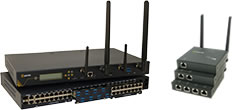
Smart city innovation: 3 models for IoT network ownership
By Max BurkhalterJuly 18, 2019
New partnerships between municipal government officials and industry-leading tech firms are helping to speed up smart city innovation, but the futuristic metropolises portrayed in popular media are still a long way off. For one limiting factor, rapid advancements in internet of things technologies have outpaced many of the security and network capabilities of municipal systems. This has forced experts in the IoT space to reconsider their approaches to large-scale deployment, infrastructural investment and data management.
To overcome these obstacles, the National Institute of Standards and Technology launched the Global Cities Team Challenge to encourage collaboration between public and private sector institutions. According to the NIST's website, the GCTC's long-term goal is to "establish and demonstrate replicable, scalable and sustainable models for incubation and deployment of interoperable, standard-based solutions using advanced technologies such as IoT and CPS, and demonstrate their measurable benefits in communities and cities." Participants are organized into "SuperClusters" centered around specific project objectives and asked to produce "blueprints" that can be used as foundational documents for smart city implementations around the world. These multi-stakeholder collaboratives have already generated a litany of valuable insights, but a 2019 publication from the Wireless SuperCluster stands out.
The Municipal Internet of Things (IoT) Blueprint
In early July, members of the WSC released a comprehensive paper on IoT network development that outlined several strategies for securing the robust connectivity that future smart city projects will require. Network applications are the backbone of any IoT-based system, from community engagement technologies to public safety infrastructure, which is why the WSC's blueprint focused on the physical and logical layers of IoT networking. Some of the key embedded technologies mentioned in the blueprint include:
- Sensors, actuators and monitoring systems
- Connected vehicles, traffic management platforms and utility controls
- Security applications, public safety equipment and physical access frameworks
The more IoT devices deployed in a concentrated area, the stronger connectivity is needed to collect, manage and analyze the generated data. This accounts for why government officials must think carefully about how their IoT networks are built and what ownership structures they will utilize.

Top 3 IoT network ownership models
According to the WSC's blueprint, the current consensus among experts is that IoT network deployments will likely fall into two primary categories, with a third "catch-all" option serving as a possible use case for non-conventional frameworks. Regardless of the ownership structure, municipal IoT has the potential to enhance service delivery, reduce operating costs, secure equitable access and more. The three ownership models outlined by the WSC include:
1. Build-and-own model: Under this ownership framework, a government or municipal agency would develop its own unique requirements for an IoT network and partner with a technology firm to build it to their specifications. In most cases, these deployments would be considered a capital improvement and/or public works project that is funded by reserves, bonds, tax revenue or a federal loan. What makes this arrangement different from other models is that the government agency in charge of the project would pay for all construction and installation costs, thereby owning the system once it's completed. The core benefit of this model is that government officials would have full control over how the network is used, though operating and maintaining the system would likely require them to hire IT professionals with advanced engineering skills.
2. Subscription/5G model: Another option is to outsource the construction and operation of a municipal IoT network to a third-party provider, most likely AT&T or Verizon. According to a 2018 study from Ericsson, around 70% of cellular firms are interested in focusing on "cellular IoT" that would utilize existing network infrastructure. While government officials would have less control over their connectivity tools, this model would undoubtedly reduce upfront costs and may secure more reliable performance, including low latency, gigabit speeds and superior indoor coverage. These sorts of agreements are already underway in many municipalities across the U.S., as the same small cell technology that enables 5G would be leveraged for smart city IoT innovation.
3. Other models: While less defined than the primary IoT network development models, this type of arrangement would likely be some form of public/private sector partnership. For example, a private tech firm could help a local municipality pay for the construction and installation costs in exchange for the right to monetize the network upon completion. Of course, this model would presumably lead to conflict between stakeholders over technical specifications, maintenance requirements and future use cases. Generally speaking, this would allow government agencies to have access to a customized IoT network, but those organizations would not have any ownership rights over the system itself.
Building the smart cities of the future will require careful planning, creativity and significant infrastructural investment. That's why Perle offers advanced connectivity tools that can help public and private sector firms integrate cutting-edge technologies. Our industrial-grade Ethernet switches and robust console servers are designed to support big data environments that depend on the uninterrupted flow of large data stores. Read some of our customer stories to learn more.



